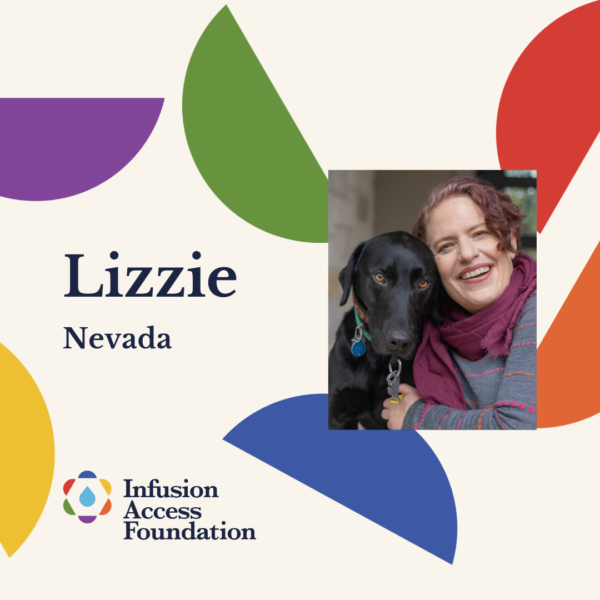I always say, “I was born an over-the-top optimist,” and I know this has shown in my chronic and rare disease journey.
Sudden Paralysis, No Warning
Ten days after my 40th birthday, I was suddenly paralyzed. I had some strange symptoms, my primary care provider was keeping an eye on, but nothing was notable. I dropped a significant amount of weight for no apparent reason and recall posting on social media about my 40th birthday, expressing how amazing I looked. Note: If you lose weight for absolutely no reason, it’s probably not a good thing. The day I went paralyzed, I remember feeling tired and just “off”. I made it through the day, but by the late afternoon, I called my primary care as I had the sensation that I was losing feeling in my legs. She told me to go to the emergency room (ER) immediately.
I don’t remember much about getting there beyond feeling terrified and being in tremendous pain. Several neurologists stood around my hospital bed, and one said something about being admitted for an “MS workup”. It wasn’t MS. It was diagnosed as a neuroimmune disease. I was discharged with a walker and instructions to go to physical therapy 5 days a week for four weeks, not to return to work for several more weeks, and a prescription for high-dose oral steroids.
I didn’t care what an autoimmune disease was, what the treatment looked like, or anything else. I wanted my life back. On the third hospitalization for what was called “transverse myelitis”, I was given IVIG or intravenous immune globulin. I didn’t care what that was either. All that mattered was that I felt strong enough to leave the hospital without the use of my walker.
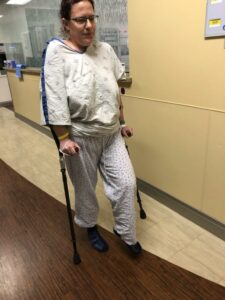
I Missed the Mountains and My Past Self
After leaving the hospital, I fell a lot. I broke several bones. When I broke my hand in two places, I realized I couldn’t work anymore. I gave my notice, packed my things, and drove with a friend several states over to live with my dad. I felt defeated, lost, and alone. People asked how I could go paralyzed when I didn’t have an accident. I couldn’t answer.
I got better physically. While I wasn’t back to where I was before, a woman who could once hike for miles and speed walk through a grocery store, I was able to walk unassisted.
During my time at my dad’s house, I ended up in the ER a lot with dehydration from lots of stomach problems. I felt weak. I felt sick, and my mental health tanked to rock bottom. I felt so alone. I didn’t see much purpose in living.
For multiple reasons, I decided to move back out west. I missed the mountains, my friends, and my son. I thought a fresh start would equate to health. Seeing the Sierra Mountains, I wanted to go hiking. I was exhausted and falling, so it wasn’t an option. Despite multiple trips to the ER, I was stuck without any new answers. No one could explain my weakness or fatigue. I remember overhearing ER doctors consulting outside my room, saying things like, “This is complex.”

Fighting for Treatment While Dreaming of Trails
Eventually, I got a referral to a neurologist who was supposedly good at solving mysteries. He ran every blood test imaginable. The one that came back immediately clear was celiac disease. I was assured that going gluten-free would eliminate my symptoms and that I would feel better. It helped lift me out of major depression (a prominent symptom of celiac disease is depression), but I still felt terrible. I saw a dietitian to begin an anti-inflammatory food plan. My diligence in improving my health showed my neurologist that I was willing to work hard at my well-being. I began taking slow, short walks and started practicing gentle yoga on YouTube. My neurologist had me do a lumbar puncture as I continued to fall. After we discussed the abnormal results, I told him how IVIG had helped 2 years previously. He diagnosed my condition as CIDP or chronic inflammatory demyelinating polyneuropathy and put in an order to begin IV steroids. The steroids made me feel terrible. I felt wired and tired. I had “monkey mind,” and it physically made me feel tingling, numbness, and pain. My neurologist put in the order to begin IVIG regularly. I didn’t have much hope, but with a diagnosis, I looked to social media groups and found others with CIDP.
After 4 months of my doctor and insurance company going back and forth, I was approved to begin treatment at a hospital infusion center. I had hope! I was using a walker, forearm crutches, and a wheelchair at this point to assist with ambulation. My insurance wasn’t transparent about the cost of IVIG. I went to multiple infusions without paying a copay, not knowing the massive debt I was racking up. I eventually received a bill for several thousand dollars, along with a note stating that payment could be made by credit card or check. I was shocked. I figured it was the end of treatment as I was starting to feel better. I had begun to formulate dreams. During my third month of IVIG, I covered the medication box where it said “human” and replaced it with “mountain goat,” and told social media that I dreamed of hiking five miles again.
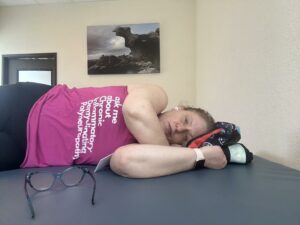
Glimpses of Stability, Shadows of Setback
Then, my neurologist ended up suddenly closing his private practice. It meant I didn’t have to go to the hospital infusion center, which I couldn’t afford, and I was switched to a small specialty pharmacy. The way they billed my insurance meant my treatment cost me next to nothing. I ended up with a great nurse and a comfy location. As much as infusions suck and make me feel terrible for a few days, I felt ready to dream about becoming a mountain woman again. It continued to be a lonely journey as my healthy friends didn’t understand what it meant to be on infusion therapy. My social media friends did, but they were all far away. I had days of feeling lost and days of feeling full of hope.
The same small specialty pharmacy that approved my treatment for low cost ended up hiring me after I wrote them a letter of gratitude for securing my treatment. I initially worked as a patient advocate, and then as a patient care manager, where I developed a health and wellness program for patients with various diseases that required infusion therapies. Unfortunately, I was out of network with my employer’s insurance plan, so starting the process of getting approved for IVIG was scary. I had to go with a nationwide, large chain specialty pharmacy that didn’t know anything about me, didn’t have an investment in getting me my treatment, and I felt like a number as I waited on hold for hours. Adjusting to change, managing my treatment plan, and working a full-time job was exhausting. I had a lapse in treatment that set me back physically. I think it hit me harder emotionally as I was beginning to see tangible improvement. In the interim, I went back on IV steroids as my insurance would pay for them. They are inexpensive, but also ineffective and risky. Unfortunately, I found out this year that I have steroid-induced glaucoma, so I’m slowly losing my vision. Steroids not only didn’t help, but they also gave me another expensive and scary chronic condition.

Stronger Through All the Changes
I got back on IVIG treatment and felt pretty well. While other diagnoses came in, I felt strong enough to manage them. The IVIG was working.
I ended up leaving my job at the specialty pharmacy due to some corporate changes, and working full-time was too much for me. Switching insurance again meant I had to go through invasive testing and back to the step-down therapy of IV steroids. A lumbar puncture left me with a spinal fluid leak that landed me in the hospital and flat on my back for 6 weeks, as it wouldn’t heal—also, more medical bills. But I got back up, IVIG was eventually approved, and I improved again.
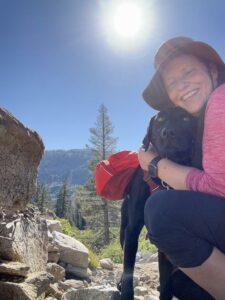
Becoming a Mountain Goat
I wish I had been better educated about IVIG. The debilitating headaches were tough. Not having a clear explanation of how to mitigate them left me searching online for information on Google and in patient groups. I didn’t know what to expect or that I would end up living a completely different life in three weeks, as every 4th week, my infusion lasted for two days and then took three days to recover. I had no clue that things like “ports” could become part of my future.
I promised myself throughout it all that if I ever recovered, I would give back to the rare disease patient community in some way. I got certified as a health and wellness coach as well as in lifestyle medicine through Wellcoaches, so people like me could have someone to talk to. Health isn’t always marked by exercise and diet. Health can look like getting back into an old hobby, adapting your life to make it easier, or feeling like you can engage with friends or family in meaningful ways. Additionally, I became certified in adaptive, accessible, trauma-informed, and size-inclusive yoga so I could teach others living with a physical disability how to move safely and gently.
In 2023, four years after I decided I would be a “mountain goat” and hike five miles, I did. I went out with my forearm crutches and my dog, and we did it. There were plenty of tears of frustration and joy as I surpassed the five-mile mark in the Desolation Wilderness. It was unbelievable.
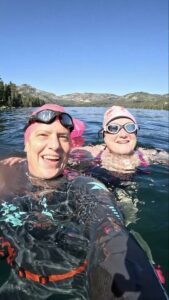
From Swimming Solo to Being Seen
In July of 2023, I joined my local master’s swim team. I knew how to swim but wasn’t a competitive swimmer. Today, I’ve turned into one! My teammates are some of the best people I’ve met. While I used to try to hide how complicated my medical picture was as I felt it would scare people away, I have spoken openly about my diagnoses and treatment with my swim team. In 2024, I completed the Donner Lake swim, a 2.7-mile swim across a high-alpine lake, despite my coach having his doubts that I could do it. I had a treatment lapse for a couple of months before and felt weak and fatigued. After making it across with a respectable time, my teammate asked, “Is there anything you could do to make it better next year?” Before I could answer, she stopped me and said, “Oh, you could actually have your treatment!” I felt understood.
My most recent IVIG infusion gave me a nasty reaction. I didn’t show up for swim practice for 10 days. When I returned to practice, my teammates were happy to see me, and one talked about how she was looking into donating plasma now that I am a real face of rare disease. Another teammate said they had.
What started as a lonely endeavor has evolved into a community effort. As we enter the prior authorization season again, I feel the familiar dread in the pit of my stomach that my insurance will deny coverage. Saying no means I can’t be a health coach for others living with a life-altering health diagnosis. Saying no means I have to deal with debilitating fatigue. Saying no means I stay home without the energy to do much. Saying no means my weakness grows, and neuropathy pain isn’t manageable. Saying no to IVIG means saying no to me, someone who enjoys helping others, pushing my limits, swimming across lakes, hiking up mountains, being a friend, a family member, a human who deserves access to appropriate treatment just like everyone else battling a tough disease.
Access to treatment isn’t just about medicine. It’s about passion, dreams, and the ability to keep showing up for the life you’ve worked hard to reclaim. We share stories like Lizzie’s to shine a light on what patients face beyond the diagnosis, and to fight for a future where no one has to push this hard to get the care they need. Jennifer “Lizzie” MacDonald wrote this story. The Infusion Access Foundation team wrote this story.






